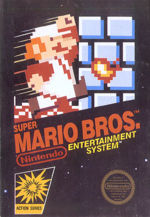Super Mario Bros.

| |
| Super Mario Bros. | |
| Developer | Nintendo EAD |
| Publisher | Nintendo |
| System | NES Gameboy Advance Virtual Console |
| Release Date | NES JP:JP September 13, 1985 US: US October 18, 1985 EU: EU May 15, 1987 GBA JP February 14, 2004 US June 2, 2004 EU August 9, 2004 Virtual Console JP December 2, 2006 US December 25, 2006 |
| Gallery | GH Gallery |
| Rating | ESRB: E |
The most well known of the Mario series, Super Mario Bros. is the game fully established the Mario series. It introduced the setting of the Mushroom Kingdom, the new damel in distress Princess Peach and the new arch-enemy Bowser. It also introduced Mario's various power-ups, including the mushrooms and stars that would become recurring parts of the Mario series.
Story
Bowser has taken over the Mushroom Kingdom and turned its inhabitants into various objects such as blocks and mushrooms. He has also kidnapped Princess Peach, the only person who can break his spell. However, Mario and Luigi are determined to defeat Bowser and save the princess.
Gameplay
The player controls Mario (Luigi only being playable through a second player) to make his way through various levels and defeat various enemies that would appear throughout the Mario series, from Goombas to Hammer Bros.. Mario is small when he starts out, but he can grow using a Super Mushroom and from there use the Fire Flower to shoot fireballs. This game also introduces the Super Star, which temporarily turns Mario invincible.
The game is divided into eight worlds, each with four levels. The last level of each world is a castle which is inhabited by Bowser - although the Bowsers in the first seven castles are actually lesser enemies in disguise. Only the eighth world contains the "true" Bowser and Princess Peach. Completing the game would unlock a second quest which is mostly identical to the first but with some changes to increase difficulty.
Legacy
Suer Mario Bros. spawned the new wave of Mario games featuring Mario as the hero of the Mushroom Kingdom, an image that still lives today. Thus many Mario games feature throwbacks and homages to Super Mario Bros. Recreations of levels have even appeared in some games, such as in Paper Mario: The Thousand-Year Door, where the player controls Bowser in nearly-identical recreations of Super Mario Bros. levels. The game is also known for its catchy music, patricularly the music in the first two stages.
Sequels
Super Mario Bros., strangely enough had two sequels. In 1986, Super Mario Bros. 2 was made in Japan. It acted as a direct sequel and was made on the same engine as Super Mario Bros., so that the games look very similar. However, Nintendo of America found the game too hard, so they editted another Japanese game, Doki Doki Panic, and released it as Super Mario Bros. 2 in America. A third part of the trilogy, Super Mario Bros. 3 was later released in both America and Japan. In modern days, the style of the original Super Mario Bros. was revived in New Super Mario Bros. for the Nintendo DS.
Ports and Remakes
- On the NES, Super Mario Bros. was later packed with Duck Hunt and World Class Champ Meet.
- In 1986, Super Mario Bros. was released for the arcade as part of Nintendo's Vs. Multisystem, with a two player game mode and some minor changes.
- Super Mario Bros. was released on the Super NES with updated graphics in the Super Mario All-Stars compilation. However, all later rereleases have instead used the original graphics.
- Super Mario Bros. DX was released for the Gameboy Color in 1999.
- It is unlockable in the 2001 Nintendo Gamecube game Animal Crossing, but so far no method of unlocking it without use of a cheating device has been found.
- The original NES version was released for the Game Boy Advance in 2004 as part of the Classic NES Series and was released on the Wii's Virtual Console in late 2006.